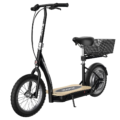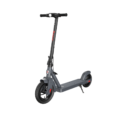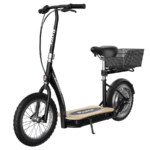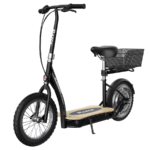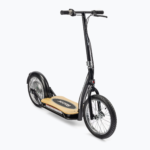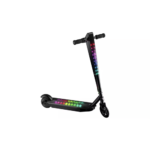- Home
- Scooters
- Electric Scooters
- Razor EcoSmart Metro R
Razor EcoSmart Metro R
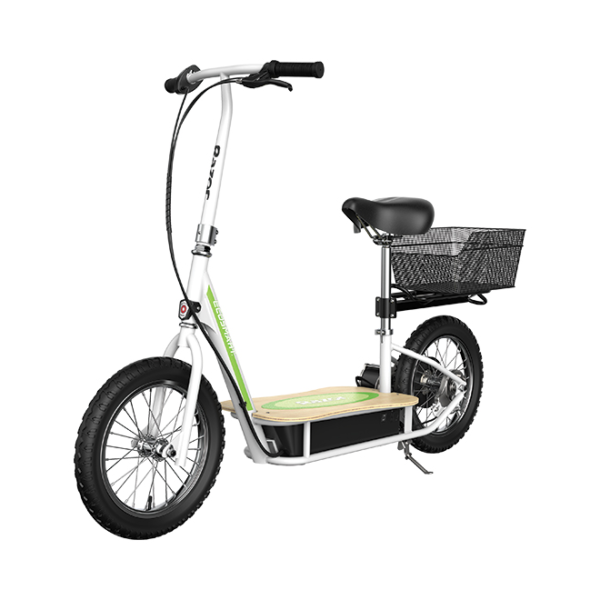



- Battery Range: 12 mi (19 km)
- Top Speed: 18 mph (29 km/h)
- Motor Power: 350–500 W nominal (model/region)
- Weight Capacity: 220 lb (100 kg)
- Charging Time: ~6–7 h
- Scooter Weight: 66.1 lb (30.0 kg)
PROS
- Seated comfort + cargo rack/basket
- 16″ pneumatics for stability
- Predictable braking and control
- Easy indoor storage and charging
- Low day-to-day maintenance
CONS
- Heavier than stand-up commuters
- Pneumatics need pressure care
- Range depends on speed/terrain
- Larger folded footprint
Table of contents
- What Is the Razor EcoSmart Metro R?
- How the Razor EcoSmart Metro R Works
- Key Specifications
- Design & Build Quality
- Performance Fundamentals
- Battery, Range & Efficiency
- Ride Quality & Comfort
- Braking & Safety Features
- Portability & Daily Usability
- Maintenance & Care
- Weather & Seasonal Considerations
- Razor EcoSmart Metro R vs Alternatives
- Who the Razor EcoSmart Metro R Is (and Isn’t) For
- FAQs
- Glossary
- Final Thoughts
The Razor EcoSmart Metro R is a sit-down, big-wheel electric scooter designed for easy neighborhood trips, relaxed campus rides, and short urban errands. It blends bicycle-like comfort with scooter simplicity, so beginners feel at home quickly. Because it favors stability and utility over raw speed, it suits riders who value comfort, a seat, and a roomy deck more than compact portability. If you’re cross-shopping its sibling, the Razor EcoSmart Metro, this guide focuses on the R variant’s seated, comfort-first mission.
What Is the Razor EcoSmart Metro R?
At a glance, the Razor EcoSmart Metro R looks like a small step-through bicycle with an electric drive. It has a tubular steel frame, a broad bamboo-style deck, large 16-inch pneumatic tires, a bicycle-like saddle, and a simple twist throttle. You sit upright, which feels natural and keeps your weight centered. As a result, the scooter delivers predictable handling on familiar streets and park paths.
Unlike compact stand-up commuters, the EcoSmart Metro R prioritizes an easy stance and day-to-day usefulness. The big wheels soften cracks and seams that would jar a small-wheel deck, and the seat removes the fatigue of standing for longer stretches. Because it rides at sensible neighborhood speeds, it reduces the learning curve for new riders while still feeling lively enough for quick grocery runs or short cross-town hops.
How the Razor EcoSmart Metro R Works
Electric scooters all share the same basic recipe: a motor drives the rear wheel, a controller manages power, a battery stores energy, and the rider commands it all with a throttle and brake levers. The EcoSmart Metro R follows this simple logic, so you can focus on riding instead of fiddling with settings.
Motor. A rear-wheel drivetrain provides smooth, predictable push. Think of it like a helper gently turning the wheel from behind. Because the drive sits at the back, the scooter stays composed when you accelerate from a stop or climb a small hill.
Controller. The controller acts as the scooter’s brain. When you twist the throttle, it meters out power so acceleration builds in a measured, linear way. Because the mapping is conservative, it avoids sudden surges that could unsettle a new rider.
Battery. A 36-volt battery pack is the most common configuration on the EcoSmart family. It feeds the controller with steady current and favors reliability over high-performance bursts. Like a fuel tank, capacity governs range; like a phone, charge habits and temperature affect longevity.
Throttle. The twist-grip throttle behaves like a dimmer switch for speed. Twist a little for easy cruising; twist more for brisk acceleration. Because it’s analog-feeling and direct, you can fine-tune pace to match bike-path etiquette or boulevard traffic.
Brakes. A hand-operated rear brake delivers familiar bicycle-style stopping. Because the rear wheel carries weight under deceleration, it bites cleanly without drama when you squeeze progressively. Most riders adapt within minutes.
In short, the Razor EcoSmart Metro R works the way you expect: twist to go, squeeze to slow, sit comfortably, and roll across town with minimal fuss.
Key Specifications
Note: Build details can vary by production run. The entries below describe the typical configuration seen across EcoSmart Metro R units without over-promising exact figures.
| Block | Details |
|---|---|
| General | Seated electric scooter; upright riding posture; tubular steel frame; broad bamboo-style deck; bicycle-inspired cockpit with twist throttle and brake lever. |
| Performance & Power | Rear-wheel electric drive with smooth, linear acceleration suited to neighborhood speeds; responsive low-to-mid pace; hill ability appropriate for gentle grades with a run-up. |
| Battery, Charging & Electrical | 36-volt system typical; smart charger; charge port mounted for easy access; simple on/off control; basic battery-status indication (varies by batch). |
| Build & Dimensions (incl. “folded”) | 16-inch pneumatic tires with inner tubes; fixed main frame; removable seat post; handlebar does not quick-fold; “folded” state generally means removing the seat post to reduce height for storage. |
| Safety & Control | Hand-operated rear brake; reflectors; bell or basic audible alert common; lighting provisions vary by package; stable, big-wheel geometry. |
| Features & Extras | Padded saddle; cargo platform or basket availability varies; kickstand; chain or enclosed drive depending on run; Cruise Control not typical. |
| Warranty & Compliance | Region-dependent limited warranty; charger typically safety-listed; observe local riding rules and age/helmet requirements. |
Because this model prioritizes comfort and utility over compactness, its key strengths are ride stability, seat comfort, and confidence at moderate speeds.
Design & Build Quality
The Razor EcoSmart Metro R feels solid underfoot. The steel frame is robust, resisting flex when you sit down or traverse driveway lips. The deck is broad and flat, so you can place your feet comfortably without searching for space. Moreover, the bamboo-style top gives it a friendly, household look rather than a “tech gadget” vibe. Fit-and-finish is practical: welds are clean, hardware is serviceable with common tools, and cable routing is tidy enough for daily use.
The cockpit adopts bicycle logic: a riser bar with comfortable sweep, a twist-grip throttle on one side, and a brake lever on the other. Because the controls are familiar, riders transition from a bicycle to the EcoSmart Metro R in seconds. The saddle is plush enough for short trips, and the height is typically adjustable via the seat post clamp. As a result, a range of riders can dial in a neutral knee bend that reduces pressure points and helps posture.
Down below, 16-inch pneumatic tires are the star. Compared with 8–10-inch scooter wheels, they roll more smoothly over seams, cobbles, and small potholes. Because they are air-filled, you can tune pressure for comfort versus efficiency; lower pressure softens the ride, while higher pressure sharpens steering and improves range. Finally, the kickstand is sturdy and placed to keep the scooter stable even with a light load on a rear rack or basket.
Performance Fundamentals
Although the EcoSmart Metro R is not built for performance bragging rights, it is lively enough to keep city riding engaging. Off the line, the twist throttle delivers a predictable ramp. Because the controller meters current gently, you won’t experience a sudden lurch; instead, you feel a smooth roll-on that helps you balance while seated. Many riders will appreciate this measured character in parking lots and shared paths.
At cruising speed, the large wheels and long wheelbase create reassuring straight-line stability. The scooter tracks true without demanding constant corrections. If you take one hand off briefly to signal, the chassis remains composed. On modest grades—think neighborhood hills around 7–10%—the Razor EcoSmart Metro R climbs best with a bit of momentum. If you start on an incline, it may need a few feet to gather itself; once rolling, it will hold a steady, sensible pace appropriate to its relaxed mission.
Importantly, the handling remains calm even over rougher patches. The tire volume absorbs chatter, and the frame resists resonance. While some compact stand-up scooters can feel twitchy above neighborhood speeds, the seated, big-wheel layout of the EcoSmart Metro R keeps steering light yet planted.
Battery, Range & Efficiency
Range is a function of battery capacity, rider weight, terrain, temperature, and speed. Because the EcoSmart Metro R runs a 36-volt architecture and favors reliability, its real-world range is designed for short to medium trips. On flat ground at modest speeds, most riders find they can complete neighborhood errands, school commutes, or campus loops without range anxiety.
However, range varies more than most riders expect. Heavier riders, colder weather, frequent full-throttle bursts, and repeated hill climbs all eat into capacity. Conversely, smooth throttle inputs, steady cruising, and correctly inflated tires improve efficiency. Because pneumatic tires can leak a little over time, routine pressure checks pay real dividends in miles covered per charge.
Charging habits matter as well. Although you don’t need a complicated ritual, adopting a few best practices helps:
- Top up after rides rather than deep-draining regularly.
- Avoid long-term storage at 0% or 100%; mid-range storage is gentler on cells.
- Charge at room temperature when possible; very cold or hot environments slow charging and age the pack faster.
- Let the pack rest after strenuous rides before immediately recharging; heat is the enemy of longevity.
Because the Razor EcoSmart Metro R emphasizes day-to-day convenience, many riders charge in the evening and ride during the day. This simple rhythm is easy to maintain and keeps the scooter ready without overthinking it.
Ride Quality & Comfort
Comfort is where the EcoSmart Metro R shines. The combination of a cushioned saddle and 16-inch pneumatic tires gives it a calm, “floaty” feel on ordinary pavement. Expansion joints and small cracks blur into the background, so your hands and back stay relaxed. Because the bar height and sweep mimic a city bike, your wrists sit at a neutral angle, which helps on longer rides.
There’s no complex suspension to tune, and that’s a feature rather than a flaw for this category. Fewer moving parts mean fewer rattles and lower maintenance. Instead, tire pressure is your main adjustment. Add a few PSI for sharper handling or drop a few for plushness. Moreover, the long deck lets you reposition your feet while riding, which helps relieve hotspots.
Stem flex is minimal for a seated model at neighborhood speeds, especially because you’re not yanking on the bar to accelerate. If you do hit a rough patch, the large tire volume and steel frame soak up the hit without harshness. The net effect is comfort you can rely on when you want to relax and look around rather than brace yourself.
Braking & Safety Features
The EcoSmart Metro R uses a hand-operated rear brake, which most riders understand instinctively from bicycles. Brake feel is progressive: squeeze lightly to scrub speed, then add pressure for firmer bite. Because weight shifts rearward under braking, the rear system remains effective without the skittishness you sometimes get from a front-only setup on small scooters.
Lighting varies by package and region. Many riders add a bright, rechargeable headlight and a flashing tail light for evening visibility. Reflectors on the frame and wheels help passive conspicuity, and a bell or compact horn is a smart addition for bike paths. While the scooter is built for stable, everyday speeds, a helmet is still essential, and riding gloves improve comfort and grip.
Finally, water resistance for seated, utility-first scooters is generally about common sense. Slow down on wet roads, increase following distance, and avoid deep puddles that can hide sharp edges. Because the drivetrain and electronics are close to the rear wheel, splashes can carry grit; a quick wipe-down after wet rides helps keep things tidy.
Portability & Daily Usability
Portability is not the EcoSmart Metro R’s focus. It is a seated, big-wheel scooter with a fixed frame. There’s no quick-fold stem, and the seat adds height. That said, daily usability is excellent if you plan to park in a garage, a covered bike rack, a shed, or a ground-floor hallway.
For storage, most riders remove the seat post to reduce height, then stand the scooter on its kickstand. The long deck and stable stance keep it upright while you load or unload a bag. Because it rides comfortably at modest speeds, you’re likely to choose it for errands where a backpack or a small rear basket makes sense. As a result, it becomes a “grab-and-go” appliance rather than a toy.
Security follows bicycle best practices. Use a quality U-lock or a hardened chain, lock through the frame to an anchored rack, and keep it in sight when possible. Moreover, consider a simple cable through the wheels for opportunistic theft deterrence. Because the scooter is heavier than stand-up models, carrying it upstairs is not practical for most people; plan storage accordingly.
Maintenance & Care
A little routine care keeps the EcoSmart Metro R running sweetly. Create a simple schedule that matches your riding:
Before each ride (30 seconds):
- Check tire pressure with a quick squeeze or a gauge.
- Confirm the brake lever feels firm and engages predictably.
- Verify the throttle snaps back cleanly.
Weekly (5–10 minutes):
- Inspect tires for embedded debris; remove sharp objects before they work deeper.
- Wipe the frame and deck; dust collects near the rear wheel.
- Check fasteners on the handlebar clamp, seat post, and brake hardware; snug them to spec with a hex key set.
Monthly (15–20 minutes):
- True the brake adjustment so lever travel starts engagement by mid-pull.
- Inspect the chain or drive enclosure for grime and tension (if accessible).
- Examine wiring near the bar and rear frame for chafe; re-position with small zip ties if needed.
Seasonally:
- Refresh inner tubes if slow leaks persist.
- Check the kickstand pivot for play; lube lightly.
- Evaluate battery charge habits; if you’ve been deep-cycling often, adopt shallower cycles to extend lifespan.
Because the Razor EcoSmart Metro R uses straightforward bicycle-adjacent parts (tubes, tires, saddle, cables), most upkeep is familiar and inexpensive.
Weather & Seasonal Considerations
Weather influences both traction and range. In rain, painted stripes and metal plates become slick, so brake earlier and roll straight across them. Because large pneumatic tires offer a broad contact patch, the EcoSmart Metro R retains predictable grip at neighborhood speeds. Nevertheless, reduce lean angles and avoid puddles that could hide potholes.
In heat, batteries and tires feel the stress. Store the scooter out of direct sun when parked, let the battery cool before charging, and check tire pressure more often—hot air expands. In cold, expect reduced range and a slightly slower throttle response until the pack warms through use. Dress in layers and consider thin gloves; warm hands improve brake modulation and control.
Across seasons, visibility is the simplest safety upgrade. Wear brighter outer layers, add reflective ankle bands, and run front and rear lights even during the day when conditions are dull. Because you sit upright, you present a larger silhouette to drivers, which helps, but active lighting is still wise.
Razor EcoSmart Metro R vs Alternatives
Within the seated, utility-oriented scooter segment, the Razor EcoSmart Metro R excels at comfort, simplicity, and everyday stability. If you compare it to compact stand-up commuters, you’ll notice these differences:
- Against lightweight commuters: The EcoSmart Metro R rides smoother and feels more secure over rough surfaces. However, it is heavier and not designed for quick folding or stair carries.
- Against performance scooters: It prioritizes comfort and predictability over high speed and hard acceleration. Consequently, it’s less demanding to ride but not a thrill machine.
- Against off-road models: The Metro R is happiest on pavement and light paths. It lacks long-travel suspension and aggressive tires, so rough trails are not its domain.
Where does the Raven-style seated class (including the Metro R) shine? Short trips with mixed surfaces, utility errands where a seat helps, and routes with mild grades. Where does a stand-up commuter shine? Multi-modal travel with frequent folding, second-floor apartments without elevators, and tight storage spaces. Where does a performance scooter shine? Longer commutes at higher speeds and steep hill work—if you accept more complexity and a stiffer ride.
Who the Razor EcoSmart Metro R Is (and Isn’t) For
Great for:
- Neighborhood errands. You can ride in casual clothes, carry a small bag or basket, and park easily.
- Students and campus riders. The seated position reduces fatigue on sprawling campuses with patchy pavement.
- New riders. The calm throttle and big-wheel stability inspire confidence.
- Short-hop commuters. If your route is flat to mildly hilly and storage is ground-level, daily use is effortless.
Not ideal for:
- Walk-up apartments without indoor parking. Carrying a seated scooter upstairs is not fun.
- Very steep hills or high-speed boulevards. The Metro R targets comfort and moderation.
- Frequent train or bus transfers. Without a quick-fold, boarding and alighting can be awkward.
In short, choose the Razor EcoSmart Metro R if you want a comfortable, low-stress electric ride that feels familiar from day one.
FAQs
1) Is there a quick “Razor EcoSmart Metro R overview” I can share with friends?
Yes. It’s a seated, big-wheel electric scooter with an upright posture, smooth neighborhood pace, and simple twist-and-go controls. It favors comfort, stability, and easy upkeep over compact folding.
2) How does it handle hills?
It manages gentle to moderate grades best. Start with a little momentum, keep a steady throttle, and expect a calm, controlled climb at a sensible pace.
3) Can I ride in light rain?
Cautious riding in drizzle is common, but slow down, brake earlier, avoid puddles, and wipe the scooter dry afterward. Long, heavy rain sessions aren’t recommended for any utility-first scooter.
4) What tires does it use?
Large 16-inch pneumatic tires with inner tubes. They absorb small bumps well and let you tune comfort with pressure adjustments.
5) Does it have Cruise Control?
Cruise Control is not typical on the EcoSmart Metro R. Most riders maintain speed with a light, steady twist of the throttle.
6) How should I store and charge it?
Store indoors, out of extreme temperatures. Charge after rides at room temperature, and avoid leaving the battery at 0% or 100% for extended periods.
7) What’s the maintenance like?
It’s straightforward: keep tires inflated, adjust the rear brake for firm bite, check fasteners monthly, and keep the drivetrain clean. Most tasks use basic bicycle tools.
Glossary
- Ah (Amp-hour): A measure of battery capacity—how much charge the pack can store.
- Wh (Watt-hour): Battery energy content (voltage × capacity). More Wh generally equals more range.
- Controller: The electronic “brain” that meters power from the battery to the motor.
- Throttle Mapping: How the controller translates twist movement into motor power. Smoother mapping means gentler acceleration.
- Pneumatic Tire: An air-filled tire with an inner tube; pressure tuning trades comfort for efficiency.
- Stem Flex: Slight bending in the handlebar column; minimal here due to seated geometry and moderate speeds.
- Regen (Regenerative Braking): Using the motor to slow and recharge the battery a little. Not a headline feature on this model.
- IP Rating: A code that describes dust and water resistance; riders should still treat e-scooters as splash-tolerant, not submersible.
- Wheelbase: Distance between front and rear axle centers; longer wheelbases track straighter and feel more stable.
- Torque: Rotational force from the motor; felt as push off the line and hill-climb strength.
- Cut-off: The battery protection that prevents over-discharge or over-current events.
- BMS (Battery Management System): Circuitry that balances cells and enforces safety limits.
- Service Interval: The time or mileage between routine checks like brake and fastener inspection.
- Rated vs Real-World Range: Lab or marketing estimates versus the distance you actually get considering hills, weight, weather, and speed.
- UL-Listed Charger: A charger evaluated to safety standards; common on reputable e-mobility products.
Final Thoughts
The Razor EcoSmart Metro R is built for people who want a calming, seated electric ride that handles daily pavement with grace. Because it pairs big wheels with a steady throttle and a roomy deck, it encourages longer, more relaxed trips than compact stand-up scooters. It won’t out-sprint performance models or fold like a pocket knife, yet it nails the everyday tasks that matter: rolling to the market, crossing campus, or meeting a friend a few neighborhoods away. If your priorities are comfort, confidence, and simplicity, this seated scooter deserves a thoughtful look.
Specifications
General
| Model The Model specifies the exact version or name of the scooter. It helps identify its unique design, features, and specifications within the manufacturer’s product line. Knowing the model makes it easier to compare options, find compatible accessories, or look up support information. | EcoSmart Metro R |
| Brand The Brand identifies the manufacturer or company that designs and produces the scooter. A trusted brand is a sign of quality, reliability, and good customer support. Well-known brands often have higher standards for safety, performance, and after-sales service, giving you more confidence in your purchase. | Razor |
| Release Date The Release Date indicates when the scooter model was officially launched on the market. This helps you know how current the design, technology, and features are. A newer release date often means updated components, improved performance, and the latest safety or smart features. | 17 November 2025 |
| Recommended Age Recommended Age indicates the minimum age range that the scooter is designed for, based on safety, size, and ease of use. Following the recommended age helps ensure that riders can handle the scooter’s speed, weight, and controls comfortably and safely. Always check local laws and use protective gear, especially for younger riders. | Recommended 16+ |
Performance & Power
| Motor Power (Wattage) What it means: The motor power, measured in watts (W), shows how strong the scooter’s electric motor is. Why it matters: Higher wattage usually means better acceleration, more torque, and improved performance on hills or rough terrain. For example, a 250W motor is good for flat city roads and light riders, while a 500W or 1000W motor provides more power for faster speeds or climbing steep inclines. | 350–500 W nominal |
| Top Speed The Top Speed indicates the maximum speed that the scooter can reach under optimal conditions. It’s usually measured on level ground with a fully charged battery and an average rider weight. A higher top speed allows you to travel longer distances faster, but always ensure you ride within legal speed limits and your personal comfort zone for safety. | 18 mph (29 km/h) |
| Battery Capacity Battery Capacity refers to the total amount of energy the scooter’s battery can store, usually measured in ampere-hours (Ah) or watt-hours (Wh). A higher battery capacity means you can ride longer distances on a single charge, reducing the need for frequent recharging. Keep in mind that actual range can vary depending on rider weight, terrain, speed, and weather conditions. | 36 V 9–10 Ah |
| Estimated Range per Charge The Estimated Range per Charge indicates the average distance the scooter can travel on a single full battery charge. This range is calculated under optimal conditions, such as flat terrain, moderate speed, and average rider weight. Real-world range may vary depending on riding style, terrain, weather, and load. A longer range means fewer recharges and greater freedom for longer trips. | Up to 12 mi (19 km) |
| Hill Climb Ability Hill Climb Ability describes the maximum incline or slope that the scooter can handle while maintaining stable performance. It’s typically expressed as a percentage or in degrees. A higher hill climb rating means the scooter can tackle steeper hills without losing too much speed or power. Actual climbing performance may vary based on rider weight, battery charge, and terrain conditions. | Up to 12° grades |
| Drive System The Drive System refers to how power from the motor is delivered to the wheels. Electric scooters typically use either a hub motor (directly integrated into the wheel) or a chain/belt drive system. A high-quality drive system ensures smooth acceleration, efficient power transfer, and low maintenance. The choice of drive system affects performance, noise level, and overall ride experience. | Rear drive (hub/chain by variant) |
Charging & Electrical
| Charging Time Charging Time indicates how long it takes to fully recharge the scooter’s battery from empty to 100% using the standard charger provided. Faster charging means less downtime and more time on the road. Actual charging time may vary slightly depending on battery capacity, charger output, and environmental conditions. | Approx. 6–7 hours |
| Battery Type Battery Type refers to the specific technology used in the scooter’s battery, which affects performance, lifespan, weight, and charging time. Most modern electric scooters use high-quality lithium-ion (Li-ion) batteries because they offer a good balance of energy density, durability, and low maintenance. A reliable battery type ensures consistent power delivery and longer riding ranges. | Li-ion with Smart BMS |
| Removable Battery A Removable Battery means the battery pack can be easily detached from the scooter for convenient charging and replacement. This feature allows you to charge the battery separately, swap it with a spare for extended range, or securely store it indoors in extreme weather. Removable batteries add flexibility and make it easier to keep your scooter powered up wherever you are. | No external fast charge |
| Regenerative Braking Regenerative Braking is an energy-saving feature that converts some of the energy normally lost during braking back into battery power. When you slow down or brake, the motor works in reverse to generate electricity, which helps extend the scooter’s range and improves overall efficiency. This system also reduces wear on traditional brake components, leading to lower maintenance over time. | Electronic assist + mechanical brake |
| Lighting Lighting refers to the built-in front and rear lights that enhance visibility and safety when riding in low-light conditions or at night. Good lighting helps you see the road ahead and ensures that other road users can see you. Many scooters include LED headlights, taillights, and sometimes brake lights or side reflectors for added safety and compliance with local traffic regulations. | Headlight + tail/brake + reflectors |
Build & Dimensions
| Scooter Weight Scooter Weight refers to the total weight of the scooter when fully assembled, including the battery. This affects how easy it is to carry, lift, and store the scooter when not in use. A lighter scooter is more portable and convenient for commuting, especially if you need to carry it upstairs or onto public transport. Keep in mind that a sturdy frame and quality components may add to the weight but also contribute to better durability and ride stability. | 66.1 lb (30.0 kg) |
| Maximum Rider Weight Maximum Rider Weight indicates the highest rider weight that the scooter is designed to safely support while maintaining optimal performance and stability. Staying within this limit helps ensure reliable acceleration, braking, and climbing ability, and it protects the frame, suspension, and motor from excessive strain. Exceeding the recommended limit may reduce performance and increase wear on components. | 220 lb (100 kg) |
| Deck Size Deck Size refers to the dimensions of the scooter’s standing platform. A wider and longer deck provides more foot space, allowing you to stand comfortably and adjust your stance while riding. A well-sized deck improves balance and stability, especially on longer rides or at higher speeds. Compact decks, on the other hand, help keep the scooter lightweight and portable. | Bamboo deck; seated cargo geometry |
| Handlebar Height Handlebar Height refers to the distance from the deck to the handlebars, which affects your riding posture and comfort. An appropriate handlebar height helps you maintain good balance, reduces strain on your back and arms, and makes steering more comfortable. Some scooters have adjustable handlebars to fit riders of different heights, while others have a fixed height for a streamlined design. | Comfort bar height |
| Folding Mechanism The Folding Mechanism describes how easily and securely the scooter can be folded for carrying and storage. A well-designed folding system lets you quickly collapse the scooter into a compact size, making it convenient to transport on public transit, store under a desk, or fit into a car trunk. Look for sturdy latches and safety locks to ensure the scooter stays firmly in place when folded or unfolded. | Folding stem (seat post fixed) |
| Dimensions Folded Dimensions indicate the size of the scooter when it’s fully folded. This measurement shows how much space the scooter will take up when stored or carried, making it easier to check if it will fit in your car trunk, under a desk, or in a closet. Compact folded dimensions are ideal for commuters who need to bring their scooter on public transport or store it in tight spaces. | 57.0 × 25.0 × 25.0 in (folded) |
| Material Material refers to the primary construction materials used for the scooter’s frame and key components. High-quality materials like aircraft-grade aluminum, reinforced steel, or durable composites provide strength, stability, and a lighter overall weight. A sturdy material ensures the scooter can handle daily wear and tear while maintaining safety and performance. | Steel/aluminum mix |
Safety & Control
| Brake Type(s) Brake Type(s) describe the braking systems the scooter uses to help you slow down or stop safely. Common brake types include mechanical brakes (like drum or disc brakes), electronic brakes, and foot brakes. Many scooters combine multiple braking systems for added safety and shorter stopping distances. The type and quality of brakes affect your control, especially when riding at higher speeds or on slopes. | Rear mechanical brake + e-assist |
| Suspension Suspension refers to the system that absorbs shocks and vibrations while riding, providing a smoother and more comfortable ride over uneven or rough surfaces. Scooters may have front suspension, rear suspension, or dual suspension for better shock absorption and stability. Good suspension helps reduce rider fatigue and improves control, especially when riding on bumpy roads or off-road paths. | Front fork + rear spring |
| Tire Type Tire Type refers to the kind of tires the scooter uses, which directly affects ride comfort, traction, and maintenance. Common types include solid (airless) tires, pneumatic (air-filled) tires, or hybrid options. Pneumatic tires offer better shock absorption and a smoother ride on rough surfaces, while solid tires are puncture-proof and require less upkeep. The right tire type helps ensure safe handling and a comfortable ride in different conditions. | Pneumatic street tires |
| Tire Size Tire Size indicates the diameter and width of the scooter’s tires, which affect ride comfort, stability, and how well the scooter handles different terrains. Larger tires generally offer better shock absorption and a smoother ride over bumps and rough surfaces, while smaller tires keep the scooter lighter and more portable. Choosing the right tire size helps ensure a balance between agility and comfort. | 16-inch |
| Kickstand The Kickstand is a built-in stand that allows you to park your scooter upright when it’s not in use. A sturdy kickstand keeps the scooter stable and prevents it from tipping over, protecting it from scratches and damage. It also makes storing and accessing your scooter more convenient, whether you’re at home, work, or on the go. | Side kickstand |
| Water Resistance Rating Water Resistance Rating indicates how well the scooter is protected against water and moisture, usually shown as an IP (Ingress Protection) rating. This rating helps you understand whether the scooter can handle light rain, splashes, or wet roads without damage. While most scooters are not fully waterproof, a good water resistance rating adds peace of mind when riding in changing weather conditions. Always avoid deep puddles or submerging the scooter to protect its electrical components. | IPX4 body |
Features & Extras
| Display/Console The Display (or Console) shows important real-time information about your ride, helping you monitor your scooter’s status at a glance. Typical displays show speed, battery level, distance traveled, and riding mode. Some models also include additional features like Bluetooth connectivity, app integration, or backlighting for better visibility at night. A clear and easy-to-read display enhances safety and convenience on every trip. | LCD dashboard |
| Ride Modes Ride Modes refer to the different speed and power settings you can choose to match your riding style or road conditions. Common modes include eco for maximum range and energy efficiency, standard for everyday balance, and sport or turbo for higher speed and stronger acceleration. Switching between ride modes allows you to customize performance, conserve battery, and ride safely in various environments. | Eco, Drive |
| Smart App Connectivity Smart App Connectivity lets you pair your scooter with a dedicated mobile app via Bluetooth. Using the app, you can monitor real-time ride stats like speed, battery level, and range, adjust settings such as ride modes or cruise control, lock the scooter for added security, and sometimes receive firmware updates. This feature adds convenience and allows you to personalize your riding experience right from your smartphone. | App-free basic operation |
| Anti-Theft System The Anti-Theft System helps protect your scooter from unauthorized use or theft. This feature can include built-in alarms, electronic motor locks, GPS tracking, or remote locking through a mobile app. A good anti-theft system provides peace of mind when parking your scooter in public spaces, adding an extra layer of security to safeguard your investment. | N/A |
| Cruise Control Cruise Control allows you to maintain a steady speed without continuously holding the throttle. This feature makes longer rides more comfortable by reducing hand fatigue and providing a smoother, more relaxed riding experience — especially on flat, open roads or bike lanes. For safety, cruise control can usually be easily activated or deactivated while riding. | No (region-dependent) |
| Accessories Included Accessories Included lists the additional items that come with the scooter to enhance your riding experience and convenience. Common accessories may include a charger, kickstand, bell, lights, phone holder, or carrying strap. These extras add value by making your scooter safer, easier to use, and ready to ride straight out of the box. | Bell, reflectors, charger |
Warranty & Compliance
| Warranty Period The Warranty Period indicates how long the manufacturer guarantees the scooter against defects in materials and workmanship under normal use. A good warranty provides peace of mind, showing the brand’s confidence in its product quality. Always check what parts are covered, such as the frame, battery, and motor, and follow the maintenance guidelines to keep your warranty valid. | 12 months typical |
| Certifications Certifications confirm that the scooter meets specific safety, quality, and environmental standards set by recognized organizations or regulatory bodies. Common certifications may include CE, RoHS, UL, or other local compliance marks, depending on your region. These certifications ensure that the scooter is manufactured to high standards and is safe and legal to use in your country. | Local e-scooter compliance |


